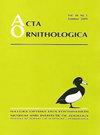在波兰筑巢的灰苍鹭的纳塔尔殖民地的分散
IF 1.3
4区 生物学
Q3 ORNITHOLOGY
引用次数: 0
摘要
摘要纳塔尔扩散是从出生地到第一次繁殖的群体的移动,而繁殖扩散是在繁殖季节内或繁殖季节之间从一个繁殖群体到另一个繁殖殖民地的移动。这些过程是遗传结构的主要决定因素,也是种群动态的关键组成部分。在这项研究中,我们调查了从繁殖季节恢复的鸟类(幼鸟、成年鸟)的年龄和/或恢复期(三个以各种气候变化动态为特征的多年期)是否会影响在波兰中欧筑巢的灰鹭(Grey Herons Ardea cinerea)从出生群体的传播距离和方向。我们发现灰鹭从出生地扩散的距离在0到392公里之间,平均值±SD 84.1±99.1公里(N=72)。与时期无关,未成年时恢复的个体比成年后恢复的个体具有更长的传播距离。我们的研究表明,代表强烈出生保真度的恢复比例(在出生地周围≤38公里的距离内,N=37,51.4%)在研究时期之间存在显著差异,1981年至2014年的恢复比例最高(71%),1932年至1939年(35%)和1940年至1980年(27%)的恢复比例较低。我们还发现,与出生殖民地的传播距离受到这一时期的显著影响,1980年至2014年的传播距离比1940年至1980年明显更短,并且有比1932年至1939年更短的趋势。出生群体的传播方向不受恢复鸟类的时期和年龄的显著影响。灰鹭的平均分布具有明显的西南方向分量。我们的研究结果表明,自20世纪30年代以来,中欧灰鹭种群缩短了与出生地的平均传播距离。这一观察结果与其他欧洲水鸟的变化报告一致。本文章由计算机程序翻译,如有差异,请以英文原文为准。
Dispersal from the Natal Colony of the Grey Heron Ardea cinerea Nesting in Poland
Abstract. Natal dispersal is the movement from the natal site to the colony of the first reproduction, while breeding dispersal is the movement from one breeding colony to another within or between breeding seasons. These processes are major determinants of genetic structure and a key component of population dynamics. In this study we investigated whether age of recovered bird (immatures, adults) and/or period (three multi-year periods characterized by various climate change dynamics) of recovery from the breeding season affect distance and direction of dispersal from the natal colony in Grey Herons Ardea cinerea nesting in Central Europe, in Poland. We found that the distance of dispersal from the natal area for Grey Herons ranged from 0 to 392 km with mean ± SD 84.1 ± 99.1 km (N = 72). Independently of periods, individuals recovered as immatures had longer dispersal distance than those recovered as adults. Our study revealed that proportion of recoveries representing strong natal fidelity (within the distance of ≤ 38 km around the natal colony, N = 37, 51.4%) differed significantly between the studied periods with the highest proportion (71%) in 1981–2014 and lower proportions in periods 1932–1939 (35%) and 1940–1980 (27%). We also found that the distance of dispersal from the natal colony was affected significantly by the period, with the distance in 1980–2014 being significantly shorter compared to 1940–1980 and with a tendency to be shorter than in 1932–1939. Direction of dispersal from the natal colony was affected significantly neither by period nor age of recovered birds. On average Grey Herons dispersed with a marked SW directional component. Our results indicate that Central European population of Grey Herons have shortened average distance of dispersal from the natal colony since the 1930s. This observation is concordant with changes reported for other European waterbirds.
求助全文
通过发布文献求助,成功后即可免费获取论文全文。
去求助
来源期刊

Acta Ornithologica
生物-鸟类学
CiteScore
2.10
自引率
0.00%
发文量
14
审稿时长
>12 weeks
期刊介绍:
Publishes scientific papers (original research reports, reviews, short notes, etc.) and announcements from all fields of ornithology. All manuscripts are peer-reviewed.
Established in 1933 as Acta Ornithologica Musei Zoologici Polonici, since 1953 continued under the present title.
Published twice a year by the Natura Optima Dux Foundation under the auspices of the Museum and Institute of Zoology, Polish Academy of Sciences.
 求助内容:
求助内容: 应助结果提醒方式:
应助结果提醒方式:


